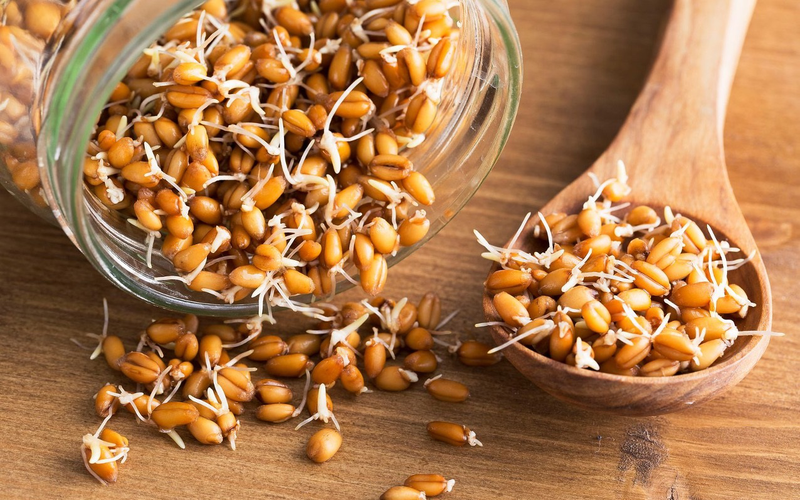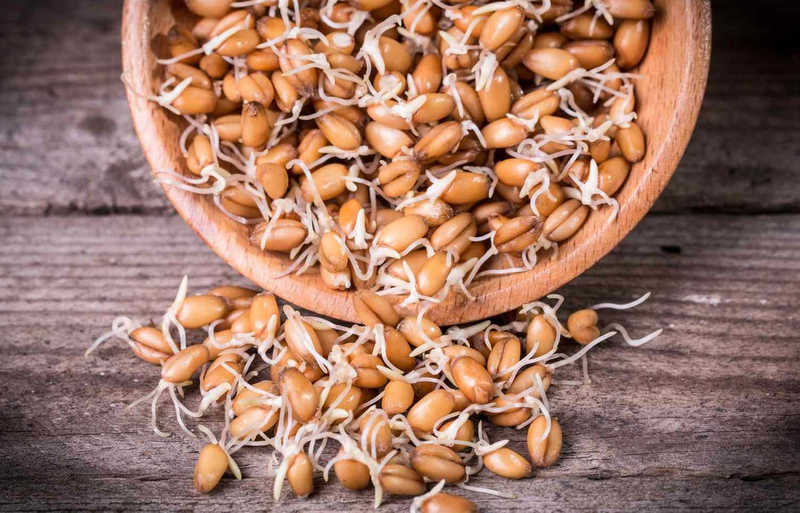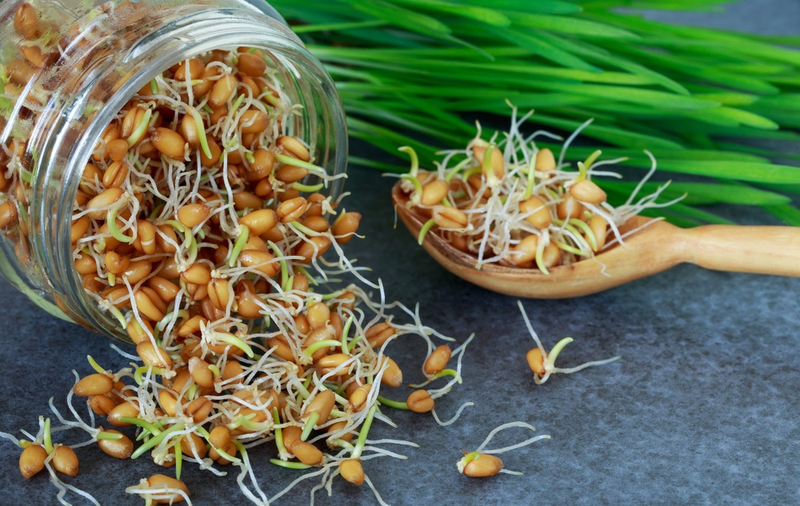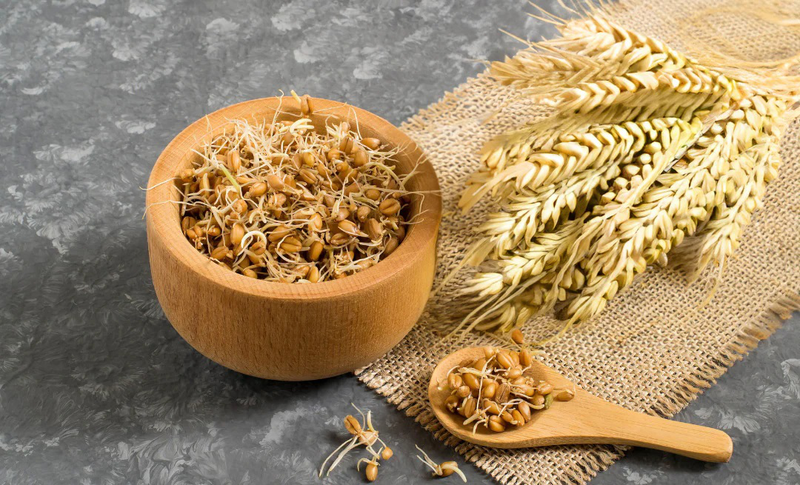Wheat germ is considered as the “pearl” of nature, containing rich nutrients. With small size but rich nutritional value, wheat germ has become a popular food for many people, especially those who care about health.
In addition to wheat grass or barley germ, in the health care community, there is a buzz about another nutritious food called wheat germ. For thousands of years, wheat germ has been known for its wonderful health benefits. If you do not know what the nutritional ingredients in wheat germ are and what its health benefits are, let’s find out right away through this article!
Nutritional composition of wheat germ
The history of using wheat germ can be up to thousands of years ago, when people began to explore and use seeds as food. People soon realized the nutritional value of wheat germ and used it as a nutritious food.
What is wheat germ?
Wheat germ is the embryo of the wheat grain when it begins to germinate. This is the stage when the wheat grain concentrates all the nutrients to nourish the young sprout to develop. Therefore, wheat germ contains a large amount of essential nutrients for the body.
Wheat germ is rich in nutrients because during the germination process, the wheat grain will convert starch into simple, easily absorbed sugar. At the same time, the process of synthesizing vitamins, minerals and enzymes necessary for the development of young sprouts occurs. These processes have significantly increased the nutritional value of wheat germ compared to whole wheat grains.

Wheat germ grows from the embryo of the wheat kernel.
Nutritional composition of wheat germ
Estimated in 100g of wheat germ there are about:
- Carbohydrates: 51.80g (About 19% DV);
- Fiber: 13.20g (About 47% DV);
- Fat: 9.720g (About 12% DV);
- Protein: 23.15g (About 46% DV).
Vitamins:
- Vitamin B1: 1.882mg (About 157% DV);
- Vitamin B2: 0.499mg (About 38% DV);
- Vitamin B3: 6.813mg (About 43% DV);
- Vitamin B5: 2.257mg (About 45% DV);
- Vitamin B6: 1.300mg (About 76% DV);
- Vitamin B9: 281.00 mcg (Approximately 70% DV).
Minerals:
- Calcium: 39.00mg (Approximately 3% DV);
- Copper: 0.80mg (Approximately 89% DV);
- Iron: 6.26mg (Approximately 35% DV);
- Magnesium: 239.00mg (Approximately 57% DV);
- Manganese: 13.301mg (Approximately 578% DV);
- Phosphorus: 842.00mg (Approximately 67% DV);
- Potassium: 892.00mg (Approximately 19% DV);
- Selenium: 79.20 mcg (Approximately 144% DV);
- Sodium: 12.00mg (Approximately 1% DV);
- Zinc: 12.29mg (Approximately 112% DV).
Amino acids:
- Alanine: 1.477 grams;
- Arginine: 1.867 grams;
- Aspartic acid: 2.070 grams;
- Cystine: 0.458 grams;
- Glutamic acid: 3.995 grams;
- Glycine: 1.424 grams;
- Histidine: 0.643 grams (About 56% DV);
- Isoleucine: 0.847 grams (About 55% DV);
- Leucine: 1.571 grams (About 46% DV);
- Lysine: 1.468 grams (About 47% DV);
- Methionine: 0.456 grams;
- Phenylalanine: 0.928 grams;
- Proline: 1.231 grams;
- Serine: 1.102 grams;
- Threonine: 0.968 grams (About 59% DV);
- Tryptophan: 0.317 grams (About 78% DV);
- Tyrosine: 0.704 grams;
- Valine: 1.198 grams (About 61%);
- Phenylalanine + Tyrosine: 1.632 grams (About 61% DV);
- Methionine + Cysteine: 0.456 grams (About 29% DV).
Note: %DV stands for % Daily Value.

Surely anyone is impressed by the nutritional composition of wheat germ.
Health Benefits of Wheat Germ
With an extremely rich and abundant nutritional composition that few foods have, wheat germ brings countless health benefits.
Wheat germ supports healthy digestion
Wheat germ is rich in soluble and insoluble fiber, both of which play an important role in maintaining digestive health.
Insoluble fiber promotes intestinal motility, prevents constipation and helps eliminate waste from the body easily. Soluble fiber nourishes the intestinal microflora, enhances beneficial bacteria and facilitates digestion. Enzymes in wheat germ help break down food, reduce the burden on the digestive system, and reduce bloating and indigestion.
Wheat germ helps protect the heart
Powerful antioxidants in wheat germ such as vitamin E help prevent the oxidation of bad cholesterol. It helps reduce the risk of plaque buildup in the arteries, atherosclerosis, heart attacks and strokes. In addition, wheat germ also helps stabilize blood pressure.
Strengthen the immune system
A series of vitamins and minerals abundant in wheat germ play an important role in strengthening the immune system. Thanks to that, the body improves its ability to fight pathogens, reducing the frequency of colds and other infections.

With its rich nutritional content, wheat germ is definitely good for your health.
Wheat germ can support weight loss
Although rich in energy, wheat germ contains a lot of fiber and protein. These are two nutrients that help you feel full longer, reduce cravings, thereby controlling the amount of calories you take in.
In addition, the vitamins and minerals in wheat germ also support the energy metabolism process, helping to burn excess fat effectively.
For example, B vitamins (especially B2, B3, B5, B6) participate in the process of converting carbohydrates, proteins and fats into energy. Magnesium in wheat germ participates in more than 300 enzyme reactions in the body, including reactions related to energy production and carbohydrate metabolism.
Helps restore and regenerate muscles effectively
Wheat germ contains all 9 essential amino acids that the body cannot synthesize on its own, including histidine, isoleucine, leucine, lysine, methionine, phenylalanine, threonine, tryptophan and valine. These amino acids are important for building and recovering muscles, especially after exercise. In addition, the abundant source of vegetable protein in wheat germ is an important nutrient for anyone who wants to increase muscle.

It would be a shame not to know the benefits of wheat germ.
How to use wheat germ to maximize benefits
In addition to the benefits mentioned above, wheat germ has many other uses. But to maximize the benefits of this food and ensure safety when using, you need to note the following:
- Wheat germ can be used in many different ways, depending on each person’s preferences and needs. Some people use it to eat directly, others use it to make cakes, porridge, nut milk or smoothies.
- When buying wheat germ, you should choose fresh sprouts, bright green, not yellowed, and without strange odors. You should avoid buying sprouts that are damaged, moldy or show signs of insect attack. Currently, there are also wheat germ products in powder and capsule form on the market for convenient use and storage.
- Although wheat germ is good for health, people with celiac allergies or gluten sensitivity should avoid using it.
Wheat germ is a wonderful gift from nature, bringing us countless health benefits. Adding wheat germ to your daily diet is a simple way to improve your health, prevent diseases and maintain youthful beauty. However, you should use this food properly and in sufficient quantity to maximize its benefits.





